A Robotic Reality
2022 has been heralded as the golden era of robotics. In this episode of The Naked Scientists you'll see how futuristic machines are already employed throughout industry to make our lives better. This isn't a tech review of Alexa, but instead a glimpse at pinpoint-accurate surgical arms completing tricky operations on human patients and tiny robots that allow food to swallow itself into your stomach. Gulp. In the news this week, the worst case of Avian Flu recorded in Europe, a Sea Dragon unearthed in Rutland UK and fish that no longer need their L plates to get on the road...
In this episode

01:17 - Worst ever avian flu outbreak
Worst ever avian flu outbreak
Christine Middlemiss, Government Veterinary Services
With cases of Avian flu appearing in the UK, Chris Smith interviews head of the Government Veterinary Services & advisor on Avian Flu, Christine Middlemiss, about how concerned we should be about this new virus amidst our current covid pandemic...
Chris - The cause is the H5N1 strain of influenza virus which doesn't, at the moment, spread well among humans. But, the situation is alarming because the virus could adapt to us and then begin to spread, potentially triggering a parallel pandemic alongside COVID - perish the thought. But there's another aspect to this: why are these viral outbreaks happening at all, and why now? Are we doing enough to stop them? Do we need to up our surveillance game? Christine Middlemiss is the UK's chief veterinary officer:
Christine - In the UK and across Europe, we are seeing the greatest number of bird flu outbreaks in kept birds that we've ever seen before. In the UK, we have 79 confirmed infected premises. Italy are having a lot of outbreaks - they're at nearly 300 - Hungary, the Netherlands, France and Ireland as well. That's because there's an overwhelming level of infection in migrating wild birds that have come back to us for the winter, and they're bringing infection and that's getting into our own kept birds.
Chris - And what sort of flu are we talking about?
Christine - Bird flu - mostly specific to birds. There have, globally, been a few reported cases - mostly in Asia - of infected people. We did, sadly, have one person infected in the UK, but he's been quite well in himself. He had very close living circumstances with his own birds. So, a very low risk to people, but it's very nasty in birds and particularly some types of birds: chickens and turkeys, particularly - it's fatal for them. That's why we want to control it.
Chris - Apart from the obvious economic and possibly food supply impact, is there a human risk down the track? In the sense that, obviously, if you've got a type of flu, and it can jump the species barrier, could it either turn itself into a form that's better at spreading among people? Could it mix up with human seasonal flu and produce a sort of hybrid which is the worst of both?
Christine - What we're seeing so far is that the genetics of this virus are very clearly linked to birds but it's important that we all keep checking. As we know, viruses can change and that's why routine hygiene precautions for people, all those things we've become really familiar with in the last two years; wash your hands every time after you've handled your birds, don't handle dead or sick birds - those things are really important so that the virus doesn't get an opportunity to think about changing.
Chris - Why is this year so bad?
Christine - Because of the overwhelming level of infection in the migratory, wild birds. The birds on the flight pathway that come to us go back to the north of Russia in the summer and that's where a number of different flight pathways all meet up. So, birds that are covering different parts of the world are exchanging their viruses and things there. Then, when they come back to us in the winter, they might be bringing different or slightly changed strains. Why we're seeing it this year when we had an outbreak last year (because usually we expect to have two or three quiet years) we're not sure. It's something we're looking really closely at because we want to think about what might happen next winter and the winter after that.
Chris - Does it teach us anything about what we need to do by way of surveillance for these sorts of infectious diseases in the future? Because one of the things people keep saying is that it's unfortunate that we weren't better prepared for what happened with COVID. Do we need better surveillance to include things like animal viruses; like bird flu?
Christine - We actually have good surveillance. I have a team that looks every day, around the world, for any changes in animal disease and animal health status. Then we translate that into what it might mean in the UK for diseases, ones we call zoonotic, that can spread from animals to people. We share that with our public health colleagues. We're really joined up in that space, but what I think we can do more of is working internationally to share information on new and emerging things, the known unknowns and unknown unknowns, so that, when, internationally, somebody somewhere spots something different, there's a pathway and route and mechanism where they can share that information so that policy makers around the world can be better informed and prepared more quickly.
Chris - All that sounds absolutely terrific, but we missed COVID didn't we? Which, I know, the jury is out on over exactly where it came from, and still people are debating about whether this is a laboratory experiment that got away or whether it really does have a genuine wildlife origin, but the end point has been the same: dramatic spread and loss of human life. A lot of these sorts of diseases do have their direct origins in animals, don't they? So, monitoring like the type you are describing is absolutely critical to keeping the lid on infections in the future. I'm just wondering how many more we might have to miss, because we missed this one?
Christine - I wouldn't necessarily say we missed this one because trying to do surveillance of all the different world's animal populations in a systematic way that would be valid enough to give you an indication - I think we have to be realistic - is, particularly when it's wildlife that might be concerned, pretty impossible. It would be really, really difficult. So, we have to understand where their interactions with other animals or people happen and monitor those spots. That's what I was conveying about sharing information internationally in a more coordinated way: people are monitoring those connection spots, but we could do it more systematically and in more of a coordinated way, working the concept of what we call one health - which is human, animal and environment health - all coming together. We're quite good now at the animal and human bit, but we need to build on having more of the environment in it so that we understand if we change something in the environment, or it changes of its own accord, we're thinking what might be the impact for animals and what might be the impact for humans.
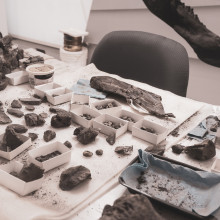
07:57 - Sea dragon found in Rutland UK
Sea dragon found in Rutland UK
Mark Evans, British Antarctic Survey
The astonishing discovery of this jurassic era creature was headline news last week, and Mark Evans spoke to Harry Lewis to explain the significance of the dig...
Mark - I guess it all started in January last year. I had an email from a colleague of mine at The University of Leicester who had been sent some interesting pictures on an email, and they seemed to show some large bones sticking out of some mud. That's pretty much all we knew. Dean and I looked and we thought we knew what it was, but we weren't entirely sure. Because I live locally - I'm only about 25 minutes from where the thing was found - we decided that I'd go and have a look. I met up with a guy called Joe Davis who manages the nature reserve at Rutland Water. Rutland Water is the largest artificial lake in the country. Joe took us out to an island on a lagoon, which is part of the nature reserve at Rutland Water, and there he showed us what he'd found just on the edge of the water. It was very, very wet, very sloppy mud, but there's enough there to confirm what Dean and I had thought we could see in the photographs: that this was part of the skeleton of a large Icthyosaur.
Harry - On this preliminary survey that you had, how much of the bone do you need to see to get that idea that you know what this dig might comprise of?
Mark - With Icthyosaurs, the vertebrae are quite a distinctive shape: they're almost like hockey pucks. If you can see them at the right angle, depending how they're exposed, then they have distinctive articulations for the ribs. It was definitely a large Icthyosaur, but at that time we didn't know quite how big this thing was.
Harry - And is there a range in the size or length of these creatures?
Mark - The smallest ones were less than a metre and the largest we know from good remains is probably about 21 or so meters, something like that. But, also, there are isolated fragmentary remains which suggests that they might have got larger than that: 25/6/7 meters maybe, which is approaching the size of large living whales.
Harry - Mark, You better put us out of our misery. What actually is an Icthyosaur?
Mark - Well, Icthyosaurs are superficially fish, dolphin or shark shaped, marine reptiles. They lived in the Jurassic period, so between about 250 million years ago, and about 90 million years ago when they all became extinct. There is a common misconception that they're some kind of dinosaur, but they're not. They're unrelated to dinosaurs. They just happened to live at the same time as dinosaurs, but all Icthyosaurs lived in the sea as far as we can tell. They had a dorsal fin, most of them, like a shark, or whale, or dolphin. They had a tail fin, which was vertical, and they had two sets of flippers, so they had front flippers and hind flippers.
Harry - What happens now? What point are we at with this preservation? What does it mean going forward? What can we learn from it?
Mark - I guess the end point of the excavation was when all of the big parts of the skeleton were encased in plaster jackets and then lifted with a great big telehandler; basically, a forklift truck with an extending arm. The skull and the surrounding matrix, the clay and the supporting frame, and the plaster work weighs about a tonne - and the abdomen, the body section, that weighs about a tonne and a half. So, there's a big job to be done for those to be cleaned for the matrix to be removed, and that's when we can start doing that part of the science on the rest of the specimen. So often you only get the head or bits of the body preserved, and here we've got the whole thing; literally all the way down to the tiniest bones at the end of the tail which are the size of a penny. When it's cleaned up fully, we'll hopefully have some really great details of the bones to look at, which will give us extra detail on these animals, but also help us to work out the diversity of animals back at this time, 180 or so million years ago, in Rutland. But it's going be a big job.
Chris - At 10 meters, this Icthyosaur is the largest ever recorded in the UK. Quite a feat. Thanks very much to Mark Evans.
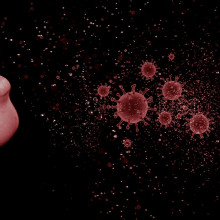
13:28 - Covid lapel sensor
Covid lapel sensor
Krystal Pollitt, Yale University
Tricia Smith interviews Krystal Pollitt from Yale University about the developments of a new sensor for SARS-CoV-2 to help us better detect the presence of covid-19 in the air...
Krystal - The clip that we've developed to monitor airborne SARS-Cov-2 is a small, wearable device that you can attach to your collar or anywhere else on your body. It has an opening in the shape of a Y that allows droplets and aerosol to then attach onto a polymer film called polydimethylsiloxane. The original motivation for use of this was: we were using this clip to measure chemicals, and this polymer is great at taking up many environmental chemicals that we are commonly exposed to.
Trish - And then, when you collect that sample, it's taken to a lab to be analysed?
Krystal - After someone's worn the clip, we have these aerosols and droplets that are collected on the polymer film. The clips are then sent to a lab and we use PCR to measure the number of SARS-Cov-2 copies that are being collected on the clip.
Trish - The device itself: is it completely reusable or is there a component there that is one use and then you have to throw it away?
Krystal - The entire clip itself is reusable. The only component that we have to replace is the polymer film, which we fabricate in the lab and is pretty simple to get in there between times people wear it.
Trish - How are you developing the air sampler? What else are you looking to use it for?
Krystal - We're all hopeful that SARS-Cov-2 and Coronavirus are not going to be a dominant focus of our lives, and that we'll live with it as cases continue, but there's also a number of other respiratory viruses that are commonly present, and that's what we've expanded to start thinking about. We've been looking at influenza as well as rhinovirus and other pathogens.
Trish - People can be actively shedding a dead version of the virus after they've had COVID, right? And that dead virus, that inactive virus, is not dangerous in terms of people getting COVID from it. Can you distinguish between live and inactive versions of COVID?
Krystal - We are only measuring total RNA copies of SARS-Cov-2. Now, if we wanted to look at the viability of those RNA copies we could because we are using this passive surface. We have deposition of those as aerosols and droplets on the surface of the film. That's not something that we're currently doing, but it's a natural extension that we could go into.
Trish - What do you think are the applications for this wearable sensor?
Krystal - We're not waiting to see if someone is infected and having them take a nasal swab, but we can see what is the potential exposure of any number of people within that indoor space that could have had a contact exposure. It could be placed in a classroom and then that could be indicative of what the teacher, as well as all the students, may have been exposed to for that period.
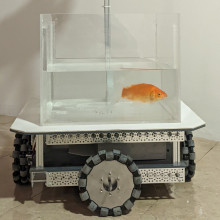
17:03 - Driving fish?
Driving fish?
Ohad Ben Shahar, Ben-Gurion University & Ronen Segev, Ben-Gurion University
Julia Ravey speaks with Ohad Ben-Shahar and Ronen Segev of Ben-Gurion University of the Negev who have been studying the cognitive behaviour of our famously forgetful sea-dwelling friends...
Julia - Call me strange, but I find driving a car to be really relaxing. It gives me a focus with a bit of peace and quiet. But, in the future, maybe we won't be driving anymore. Various tech giants are beavering away trying to perfect automated vehicles, but what they maybe haven't considered in their grand plans is goldfish. I was scrolling on Twitter and one of the most bizarre yet fascinating videos popped up in my feed of a goldfish steering a tank on wheels with surprisingly good accuracy, and this was all in the name of science. I reached out to Ohad Ben-Shahar, a researcher behind this work, to see if carp-ools could be what the future of driving has in store.
Ohad - Julia, you might find it shocking, but fish don't drive cars. Trying to make them do so, even though it sounds cool, was not our end goal. In fact, making fish drive your robotic vehicle is part of our broader agenda to explore how animals represent the surrounding space in their brain and how they make navigational decisions.
Julia - Ohad and fellow researcher, Ronen Segev, wanted to get the goldfish on the road to test their navigational skills. But, as Ronen explains, there is one problem with wanting to teach a fish to drive.
Ronen - Okay, clearly you cannot ask a fish to do that. So you need to train it in stepwise manner.
Julia - The researchers used their powers of persuasion to get the fish behind the wheel: a target and some fish food. The goldfish were placed in a special robotic tank on wheels, which moves according to where the fish swims. When the fish tank hit the target on the wall, the goldfish would be given a treat, teaching them that this target was one to chase.
Ronen - After training, which is usually 10-15 sessions, each one of them 30 minutes in total, they actually managed to go directly towards the target in order to consume as many food pellets as they could during the 30 minute session.
Julia - And it seems the goldfish were specifically eyeing up the target: they managed to seek it out even when the researchers were being a little bit fishy.
Ronen - One thing to do is to take the target and place it on the other side of the room. So, initially, what you see is that the fish goes to the previous location, but then it actually finds out that the target has moved and it goes directly to the new target. So, this thing that we do in the experiment, actually manipulating the arena where the fish needs to navigate, actually makes us believe, and it's very convincing, that the fish indeed controls the vehicle, managed to drive the vehicle, and also remembered the surroundings and navigated towards the target.
Julia - Do we think fish use this type of navigation - remembering landmarks or cues - in the wild.
Ohad - Visual landmarks must play a role in their navigational decisions just as it helps us humans. But I want to be slightly careful here: we have currently studied only goldfish. So, at the moment, we can't really generalise to all species of fish, but studying other species is indeed part of our plan in the near future.
Julia - Ronen and Ohad want to go further than just looking at the goldfish's movements in this somewhat bizarre driving scenario, and also peek into their brains when they navigate in open waters.
Ohad - What we ourselves are currently developing is the ability to record the activity of single cells in the fish's brain: Why it is behaving completely naturally in its environment? We hope to find the links, if you will, between behavior and the neural coding, and hopefully understand how navigation decisions are indeed represented and made in the fish's brain.
Julia - The results from this experiment, to me, makes it seem like goldfish are pretty sophisticated if they can do this type of navigation. Should we all stop using the phrase, "You have a memory like a goldfish", when someone's a little bit forgetful.
Ronen - Yes, of course. As someone who has worked on fish for many years, these animals are amazing! They constitute something like 35,000 different species and they do amazing things. So, definitely, we should stop thinking that fish have low cognitive capabilities or things like that. They just live in a very different world than us and they solve different things differently.
Julia - But we've got no chance of water-mated vehicles coming along anytime soon?
Ronen - No, I don't think so.
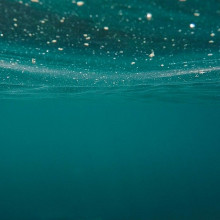
26:55 - The adventures of Boaty McBoatface
The adventures of Boaty McBoatface
Maaten Furlong, National Oceanography Centre
Boaty McBoatface, an autonomous underwater vehicle, is one of a fleet of robots cared for by Maaten Furlong at the National Oceanography Centre. He explained to Chris Smith what exactly Boaty McBoatface is, and what it looks like...
Maaten - Well Chris, it's a little yellow submarine. It's about 3.5 meters long, weighs about 750 kilos. It's got a propeller at the back and some control planes. It's also got little stubby wings, which allows it to go up and down through the water column. It's designed to go a really long way. Thousands of kilometres and many months of endurance, but its primary purpose is actually just to carry sensors. We view these things as sensor taxis, and you can fit whatever sensors you need for a specific size campaign that the vehicle is working on.
Chris - Thousands of kilometers? That's a lot. How is it powered?
Maaten - It's battery powered. It has a whole set of lithium batteries, which are single use batteries, alongside some rechargeable sets in there as well. It goes very slowly, so it doesn't use very much energy for propulsion, and we run low power sensors there. But it has a very big battery pack. It's got the same amount of energy that you'd get in a for example a Nissan Leaf.
Chris - And so for underwater robots like this, what is their main aim? Why have you got them?
Maaten - They're a generic tool for supporting the oceanographic community. There's a whole fleet of different Marine robots, which we run at the Oceanography Centre. Boaty is just one. They're used to carry sensors to different parts of the ocean, to understand what's happening in that specific location. Whereas on terrestrial plains, you can use satellites to get huge areas and visualize huge areas of the globe. However because of the properties of seawater, you have to move your sensors to the specific location you want to measure. All of these vehicles are there to take measurements of the ocean, and it depends on the sort of science which is being undertaken. Some of it is looking at the structure of the water column, others looking at actually what's happening on the sea bed and the geology, and other things are looking at the biology that's there. Whether it's big marine animals or whether you're looking in the deep ocean and you're looking at some of the creatures which are on the bottom of the abyssal plane 4,000 meters down.
Chris - Do they follow a pre-programmed mission, or do they actually make decisions for themselves?
Maaten - This depends on the vehicles. Generally they will follow a pre-programmed mission. For example, Boaty is designed to go a very long way, but what it's actually composed of is a lot of short little missions. We will tell it to go and do a little mission. It will dive down, it'll go and do a survey, it'll come to the surface and then it'll talk to us via satellite and ask us what we want it to do next. You can stitch all of these little missions together, but during the actual mission it's operating completely independently. It will be taking measurements of its environment to try and avoid bumping into things and make sure it doesn't get lost. And then it'll come back to the surface. Other vehicles that we have are less autonomous. You have remotely operated vehicles and these are controlled from a ship typically down a long cable to a robot, which is on the bottom end of a wire. People are also looking at surface vessels and these are uncrewed surface vessels and they would be controlled from shore typically. There were people working on the situations where you'll have a control station running an uncrewed surface vessel somewhere in the ocean, and then that will be deploying an a R.O.V. that you can control remotely from shore. You will see what's happening at the bottom of the ocean and be able to manipulate the bottom of the ocean, thousands of kilometers from shore, remotely from a shore station.
Chris - What can we do with these things though that we couldn't do before? Do they actually unlock new realms to us or for us, or is it just a question of whether it's more practical to operate this way?
Maaten - They have some unique capabilities. You mentioned Boaty being in Antarctica, so it's currently on a campaign to look at the Thwaites Glacier and it will be going 10's of kilometers in from the ice front. There's a big ice glacier floating on the Antarctic sea and Boaty will go from the front of the ice, 20, 30, 40 kilometers in, to study what's happening underneath it. You could do that with a manned submarine, but it'd be incredibly dangerous and incredibly expensive. Also there are other systems. There's an array of robotic floats in the ocean. These measure the structure of the ocean and the deep ocean and there's 4,000 of them sending back data which allows you to run ocean models and predict impacts of climate change. You could technically do this with ships, but it's just so much more efficient to do it with robots.
Chris - It's good to hear there are all those advantages. We're pushing the boundaries and boldly going where no unmanned autonomous vehicle has been before. Maaten thank you very much, indeed, for telling us all about it. That's Maaten Furlong, who is the caretaker for Boaty McBoatface, among others.
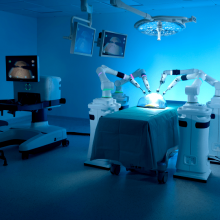
32:55 - Getting to grips with robotic surgery
Getting to grips with robotic surgery
Mark Slack, CMR Surgical & Mario Bento, CMR Surgical
When it comes to medicine, robotics is becoming very big business: the venture we’re about to hear from are industry “unicorns” - these are start up companies that have been valued at over a billion - thanks to their technology that can make the benefits of keyhole surgery available to everyone who needs it. Tricia Smith spoke with chief medical officer and co-founder Mark Slack, and implementation executive Mario Bento, to find out more...
Tricia - I'm at CMR surgical, which is a medical robotics company based in Cambridge. I'm here to have a demo of, and have a look around the Versius system, which is a medical robot that assists surgeons in performing laparoscopic surgery. Hopefully I don't break anything. What's the difference between normal laparoscopic surgery and that where you've got a robot assisting you?
Mark - Normal laparoscopic surgery is keyhole surgery, and that's doing your surgery through tiny little holes. Now these huge advantages of keyhole surgery over open surgery, to you give you one statistic, you reduce surgical complications by 50% doing exactly the same operation by keyhole rather than by open surgery. However, in the world, only about 30 to 40% of people who could have keyhole surgery, do get it. The reason for that is it's really difficult to do. If you bring in robotic keyhole surgery, the end of the instrument is articulated. It behaves like a hand or like a wrist. In conventional keyhole surgery, the slang term for it is 'straight stick surgery' because the instruments have no articulation. That makes it incredibly difficult to do; That's where the difficulty comes.
Tricia - What's different about the Versius system compared to other robot assisted laparoscopic devices?
Mark - We've got a very different design from the other ones that makes us able to have a smaller robot. It's able to be placed more efficiently around the table. We can get better reach and that just widens the scope of what we can do. We can do surgery everywhere from the chest to anywhere in the abdomen.
Tricia - Is there anything that's automatic or does the surgeon have complete control over everything?
Mark - If I had a person standing next to the table and they wanted to get close to do something, they could push the arm across and I won't know that the arm's been moved because it adjusts automatically. The tip, where it's working and what it's doing, stays exactly where it was.
Tricia - And the tip staying exactly where it was is important because the surgeon needs to have complete control over what's happening in the patient.
Mark - The word is precision. That's what you want. You want absolute accuracy and precision in surgery. And that's what the robot gives us.
Harry - Yeah. It's time to get up close and personal with the equipment and Tricia got that chance to play surgeon with implementation executive Mario Bento.
Tricia - I can see clearly that at the bottom of this plywood prototype, there's a joint that looks like a shoulder further up, something looks like an elbow. You can see a wrist and then it's perhaps got a hand that's holding a long rod.
Mario - The system consists of the Versius console, which is the brain of the system and consists of four Versius arms. The console itself is where the surgeon would sit or stand.
Tricia - Attached to this rolling brain of the operation, which has a very large screen, it basically looks like there are two little nunchucks which have joysticks and a couple of buttons attached to these arms that then have a freedom to move around. I'm assuming that that's how the surgeon then operates the robotic arms.
Mario - Yes. As we can see when the console is turned on, the controllers actually float. Also, there's just enough space between where the surgeon sits to where the screen actually is, which maximizes that 3D view that the console has. You'll always need your 3D glasses to actually see the 3D screen, of course.
Tricia - Oh gosh. That's amazing. I'm leaning forwards and backwards and I'm looking at this screen and the field of view is getting closer and further away, but it's definitely three dimensional.
Mario - The controllers themselves have 3 sensors on each controller that detect someone's hand. It's a safety feature of the robot itself. It knows if I am holding the controller appropriately, it allows me to use the instrument. But as soon as I let go, or if it doesn't recognize my hands, if I'm not holding it properly, it won't let me move the instruments.
Tricia - Okay. I have to hold these joysticks to engage, so I'm allowed to move. I press a button with my thumb that says, 'start using this arm'. And then if I press my first finger, it's kind of like the trigger on a joystick and I can close and open the instruments. Hopefully I won't collide with anything.
Machine - [beeps]
Tricia - There we go. I've gone wrong. I've got something flashing on the screen in front of me and also the robotic arm by the operating table is flashing too.
Harry - It's not to worry. Mario got the kit up and running again eventually, but Tricia thought she would leave the robotics with the professionals. Just enough time though, to revisit Mark and discuss her experience.
Tricia - I had a go. I wasn't very good, I have to say. But one thing I noticed was how ergonomic the setup is when you're operating and the support that you have, and the fact that you can let go and everything pauses, it's like pausing a video game. Why is that important in terms of the safety to the patient and also in terms of the comfort and the safety to the surgeon?
Mark - There are multiple sides to that. Fatigue during normal keyhole surgery means that you're struggling and you're probably more prone to make errors. There's a little known fact that many senior surgeons get a lot of musculoskeletal difficulty from operating. That's one big area. A lot of the instruments that are made are too big for female surgeons to use because their hands tend to be smaller. Those are all things that the robot can help overcome. We pay a lot of attention to the ergonomics. I don't want to see surgeons being injured and then having to end their careers because of neck problems, so we see that as a very important part of the program. They are more rested while they're operating, which means better outcomes, and they remain able to operate for longer.
Tricia - Do you think that in the future, we are gonna have fully autonomous robotic surgeons?
Mark - I don't think in our lifetime. But what I do see the robot introducing is a system between the surgeon and the patient. That allows us to do all sorts of other exciting things. We can actually standardize surgery. We can put checklists onto it. Every time they arm moves, the computer is registering its movements. Every high end movement to the surgeon is measured as well and we started to correlate that with outcomes. When you go and have your operation, wouldn't it be nice to know how good your surgeon is?
Tricia - These robots not only are tools that allow us to access the body in a minimally invasive manner. They also give feedback that wouldn't otherwise be recorded if you did a manual laparoscopy.
Mark - All the data that is got through there, when you talk about AI and things like that, that's where we are going to mine a lot of data. And potentially we'll come to a point where it can warn you that you're about to make a mistake. Those are the sort of things that I'm looking towards as being futuristic.
Harry - Tricia Smith, speaking to Mark Slack and Mario Bento from CMR Surgical there. We're discussing some of the novel ways robots are pushing the boundaries of human endeavour.
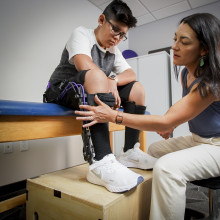
40:51 - Robotic exoskeletons
Robotic exoskeletons
Zach Lerner, Northern Arizona University
Researchers at Northern Arizona University have developed a robotic ankle exoskeleton that doesn’t just help you get up the stairs if you’re suffering from an injury but could also be fundamental to rehabilitation. Tricia Smith talks to Zach Lerner to hear how...
Zach - It's really easy to make a wearable robot that makes walking more difficult. It's much harder to make a wearable robot that makes walking easier. What I mean by that is, when you add something to the body, when you add heavy motors and batteries, it can actually be detrimental. Especially if you place them on the feet or the lower legs. It's really metabolically expensive. It takes a lot of energy to move heavy limbs.
Tricia - So with the wearable exoskeleton that you've developed, can you explain to me what it looks like and how it works?
Zach - We've designed our ankle exoskeleton in such a way where the heaviest components are located close to the waist, like a location where you would carry a Fanny pack. Then we have cables that travel down the leg and they actuate pulleys on an ankle assembly. Then there's a foot plate and a calf cuff and this rotary joint that's actuated by these cables, and it's driving the foot in a particular direction.
Tricia - What's the difference between using the exoskeletons for rehabilitation and also using it for assistance.
Zach - The device can be controlled to provide torque or forces that interact with the body that work in conjunction with the muscles. The reality is that no one wants to wear a leg brace for the rest of their lives, so we've been developing a technique where we actually provide resistance to the body at a particular point in the gate cycle. It's training muscles to turn on at a particular time when it's most beneficial for efficient walking.
Tricia - By using these exoskeletons in resistive mode, without wearing it, their day is improved.
Zach - That's exactly right. It's been really remarkable how quickly our participants in our clinical resource studies have improved. In as little as 10 sessions over 4 weeks, we've seen a remarkable improvement in their walking speed and in their walking pattern. We can actually make people better. We can improve their underlying function, even when they're not using the device. It's really exciting to think about devices that can go home with individuals and can be used daily for functional training, and to allow a connection between a physical therapist who could remotely monitor their patient's progress by just using the onboard sensors that are embedded into these devices.
Tricia - And when these devices are working in 'assistive mode', how do you make that device able to adapt to a changing environment?
Zach - The approach that we've taken is to embed 4 sensors under the forefoot. This allows us to approximate what the calf muscles are trying to achieve. Using this as a proxy measure for someone's intention, these sensors can capture when someone is naturally speeding up or slowing down or walking on stairs or a ramp. And it's also important that we have control strategies that are able to adapt to different gate patterns. They're able to adapt to different neurological conditions, different people using the device. In some ways, the mechanical design of a wearable robot is the easy part. The control of the device can sometimes be much more difficult.
Tricia - What do you see exoskeleton technology looking like in the future with advances?
Zach - We're going through a really remarkable period of electrification of personal mobility. Electric skateboards, electric scooters, and in the wearable robotics space, we're electrifying joints. We're benefiting from the proliferation of affordable batteries and improvements in battery capacity, the large scale productions of appropriately sized motors. As the wearable robotic space grows in conjunction with electrified mobility, we'll see the benefits of devices that are more affordable and more effective because they're smaller, they're lighter and they can use be used for a longer period.
Chris - Zach Learner there speaking with Tricia Smith.

45:27 - Will robots become artificial organisms?
Will robots become artificial organisms?
Jonathan Rossiter, University of Bristol
Jonathan Rossiter is Professor of Robotics at Bristol University, and he believes that one day we will scrap the word robot for the term artificial organisms, but what does that mean? Harry Lewis finds out...
Jonathan - I think there have been many preconceptions in robotics. People have a look at science fiction and they maybe see their robot vacuum cleaner that's moving around their homes. They think of robots as conventional, made out of metal and plastics and so on. And that's great. We make 10 million of those around the world, and that's wonderful. But if you look at organisms in nature, they have really exciting properties, which are really quite similar to robots, so we can think of robots more in the lines of an organism.
Harry - Where does this feature and where does it end? Is there at all a chance that these robots, if we're starting to term them like organisms, might be feeding and getting energy from similar places that we do?
Jonathan - Yeah. If you think of a robot, a robot has got a body made out of plastic and metal, and it's got a battery where it gets energy from. Then it's got a brain which is made out of a silicon chip or a computer. Whereas artificial organisms, the kind of thing that we work on in Bristol, they have a stomach which eats biological food; It gets energy from food. It's got a body which is soft and compliant like a normal organism, and it's got a brain which is much more like a biological brain. Now, one of the really interesting things about these robots is that we can make them out of materials, which are soft and compliant, and that can biodegrade safely into the environment. That changes the way in which you make the robots and the way in which you can use them.
Harry - How exactly do those artificial stomachs work? How do they transfer the energy from inside the stomach, to the robot?
Jonathan - One of the challenges in making an artificial stomach is that you have food, which is chemical energy, that needs to be turned into electrical energy. One way to do that is to employ something which is naturally occurring in the environment, which is microbes. The microbes can eat the food for us, and then they break it down and generate electrons and protons, the important parts of electricity, and then we use those electrons in our circuit, in our robot.
Harry - So when we're speaking of these soft robots, what materials are you using?
Jonathan - One of the examples I use is like a 'gummy bear' robot, a robot that's made out of a jelly-like material, similar to what you might get in candy and sweets. And that's got some really interesting properties where when you pass electricity through it, it can do something interesting. It moves a little bit like a muscle. Once you've made a robot out of that, it can move on its own. Then at the end of its life, because it's a little bit like a gummy bear, it can biodegrade to nothing. Microbes in the environment will eat the robot and it'll be safe.
Harry - So we've heard Jonathan about how robots are going off to carry out difficult bits of difficult tasks that we can't handle. What is the purpose of having something that's biodegradable? Why is that useful to us?
Jonathan - One of the challenges with current robots is that you can make 10 of them and 100 of them, and you can put them out into the environment, like in the Atlantic ocean to monitor the sea there, but at the end of their life you've got to bring them back. You've got to track them and capture them and bring them back. Otherwise they pollute the environment with a biodegradable robot. You can deploy hundreds, thousands, millions, billions, trillions of these robots. They'll do something really useful, like monitor the environment, and when they reach the end of their lives you don't have to bring them back. You just leave them to degrade and they can have a net positive impact on the environment. That's something we really find very difficult to do with conventional robots.
Harry - I mean it sounds fantastic Jonathan, and something that you'd never consider when you're talking about electrical items or things that we're using for tools to go out and find us information. There must be quite a few challenges creating biodegradable robots because I can't imagine that the technology is there before you. This is something very novel. What are those challenges?
Jonathan - We have to make those three components, the body, the brain, and the stomach, and they each have their own challenges. The body, we have to make these artificial muscles, which are effective. They've got to be as strong as our biological muscles. The stomach has got to be as effective as our stomach at turning food energy, which is incredibly rich in energy, into movement as it were. And the computational side, we want to make computers and artificial intelligence for these robots, which isn't made out of the kind of thing you can find in your mobile phone, a piece of a silicon chip because that doesn't biodegrade very well. We have to look at those technologies and we're doing a lot of work in this and I think maybe in 5 to 10 years time, we can show the kind of first examples of these technologies.
Harry - That's a good question looking towards the future, in 5 to 10 years time or perhaps looking past that as well in a few decades, where do you see the field of robotics going? I know that through speaking in this last half hour, we all know that robotics is such a big field, but where in particular do you think those advancements lie?
Jonathan - I don't think there's any limit actually to where the robots will be. I term 'future robots' as ubiquitous and it's probably gonna be the case that we don't even refer to them as 'robots' because they will be around us. They'll be with us, they'll be on us as part of our clothing, they'll be inside us as food that we eat, and our organs inside, when they go wrong, will be replaced by robotic organisms. So really our lives and our future are very much entwined with these new styles of robots.
Harry - Is there an example, is there a piece that's sitting in your lab at the moment that you can describe to us and what the function might be for it?
Jonathan - At the moment we are working on edible robots as robotic food, and you think, "Well, hold on, if I've got a plate of spaghetti, why would I ever want it to be robotic?" Well there are several reasons. If you have a young child, for example, who doesn't like to eat their food, if the food is more entertaining on the plate perhaps that's gonna encourage them to eat it. That's kind of trivial, but actually a quite important example. Now an even more important pressing example is people who've had a stroke for example, and they can't swallow very well. What happens if your robotic food would swallow itself into your stomach? You put it in your mouth and it would worm its way into your stomach. There you have the pleasure of eating, you don't have to eat some horrible, thin down liquid and the food will deliver nutrients exactly where it's needed. That's the work we're developing at the moment and we think this is gonna take a bit of time, but it's really exciting.
Harry - Thanks there to Jonathan Rossiter.

52:31 - QotW: Why can't I fall asleep with cold feet?
QotW: Why can't I fall asleep with cold feet?
Otis Kingsman burnt the midnight oil to get to the bottom of this one. Fortunately, Guy Leschziner Professor of Neurology and Sleep Medicine at King's College London, let him in on the secret to a great nights sleep...










Comments
Add a comment